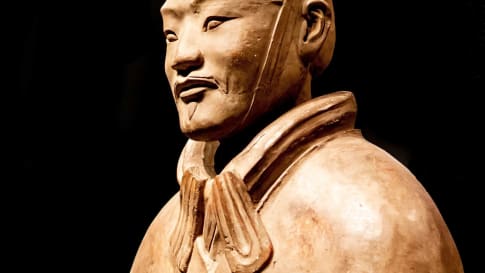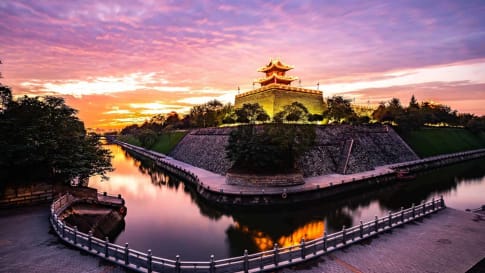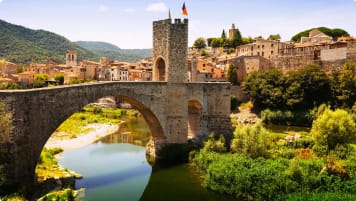Travel on the Silk Road with Odyssey Traveller | Small Group Tour for Seniors
The Silk Road is an ancient trade route linking China and Imperial Rome through Central Asia. Few areas in the world remain as unexplored or offer such richness in terms of ancient and modern history, culture, and scenic diversity as Central Asia. Our Small group Silk road tours itinerary explores the Road through remote deserts and mountainous environments as we visit key sites between Xi'an and Bukhara.
From $17,852CAD
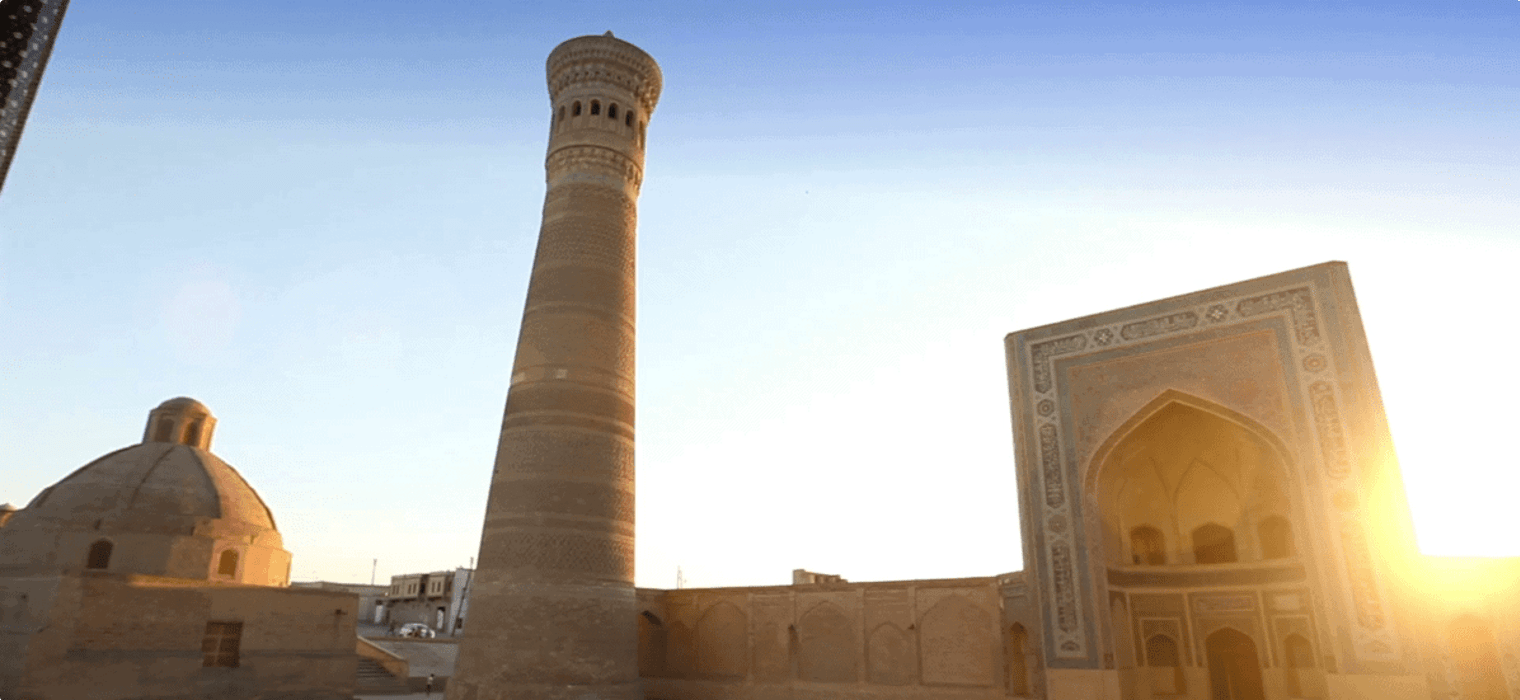
Highlights
- 1. Visit the Savistky Museum in Nukus and view the world's second largest collection of Russian avant garde art
- 2. Take in breathtaking views of the Tien Shan mountain range and Issyk Kul in Kyrgyzstan.
- 3. Explore the tomb of Emperor Qin and the Terracotta Army, one of the world’s most remarkable archaeological finds.
- 4. Spend time in the fabled Silk Road cities of Bukhara and Samarkand, centres of religion, trade, and scholarship.
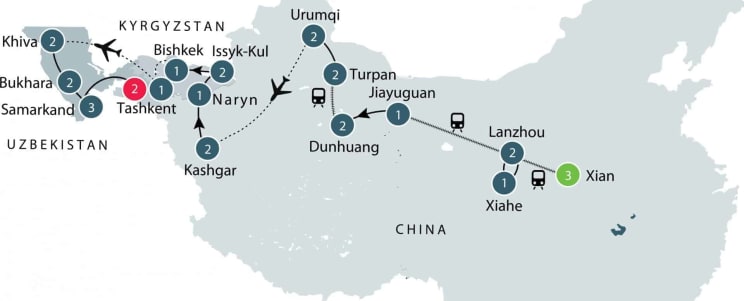
Departure Dates
| Departure Date | Price |
|---|---|
| 28 August 2025 Ends 25 September 2025 • 29 days $17,852 Twin $20,709 Single Available | Selected |
| 04 May 2026 Ends 01 June 2026 • 29 days $18,759 Twin $21,207 Single Available | |
| 03 September 2026 Ends 01 October 2026 • 29 days $18,759 Twin $21,207 Single Available | |
| 19 April 2027 Ends 17 May 2027 • days $19,040 Twin $16,551 Single Available | |
| 16 September 2027 Ends 14 October 2027 • days $19,040 Twin $16,551 Single Available |
Silk Road Small Group Tour
Odyssey Traveller’s 29-day fully escorted small group Silk Road tours for seniors take you on a journey across the Eurasian steppe, tracing the ancient trade routes collectively known as the Silk Road. This guided small group tour is for couples and solo travellers, it follows the Silk road across three countries, China , Kyrgyzstan and Uzbekistan . Some Silk road travel tours only offer the China Silk road tour , this is not one of them. Our next departure will be Silk road tours 2025, along this trade route.
The ancient Silk Road facilitated a two-way exchange of goods and ideas and led to the prosperity of cities supplying the routes’ ports and markets of trade. The UNESCO World heritage site has a full list of the Silk Road cities , which includes Guangzhou and Xi'an ( China ), Isfahan ( Iran ), Bukhara and Samarkand ( Uzbekistan ), Jeddah (Saudi Arabia), Baku(Azerbaijan), Almaty ( Kazakhstan ), and Venice (Italy), these emerging cities show today how the silk road an ancient world of adventure built ancient China and the regions beyond through the trade of desired goods in both directions. Marco Polo possibly was the first to describe the silk road an ancient world of adventure to his scribe sitting imprisoned in Genoa revealed much about the Silk road route and its importance to both East and the West. But the Roman empire centuries before showed how silk exceeded the price of gold and was the must have fabric for both sexes, until it was outlawed for men to wear Chinese silk.
This guided tour will take you to the Silk Road cities and important stops in China , Kyrgyzstan (to reach the Silk Road border post of Naryn), and Uzbekistan and give deeper knowledge of the Silk Road’s incredible legacy. The history of it is amazing, as are the explorers and archeologists of the Silk Road who in the 19th century had the opportunity to explore and uncover the legacy of silk road travel over the centuries.
Odyssey Traveller’s Silk Road tours from Australia, USA and Britain explores how diverse cultures from both east and west, north and south, have shaped this region for over 2,000 years. We will be accompanied throughout the tour by an Odyssey Program Leader. In both China and Uzbekistan, there will be English-speaking national guides throughout. Local guides will also be present along the way to assist in the interpretation and presentation of information. This tour is designed for the active senior traveller keen on learning more about history, viewing incredible scenery, and embarking on a unique adventure. To prepare you for this tour we have prepared a reading of list books on the Silk road to read before you join the tour in Xian.
Silk Road Tour Itinerary
Xi'an, Lanzhou and Xiahe
Xi'an was the eastern terminus of the Silk Road and China's oldest ancient capital , the perfect place from which to commence our tour along this ancient trade route. It possesses the longest history of any of China's cities.It is home to the famous Terracotta warriors army Our silk road journey then takes us in to Western China and Lanzhou, the capital and largest city of Gansu Province in Northwest China. We venture further across western China, into the Xinjiang province, an Autonomous Region of China. Xiahe is an ethnically Tibetan old town, home to sprawling monasteries and the verdant Sangke Grassland.
Heading north-west
As we continue north-west, we take in the western termination point of the Great Wall at Jiayuguan. Jiayuguan is the site of the largest and most intact pass of the Great Wall of China. We will visit the Overhanging Great Wall , an important part of this region's defence. The nearby area of Dunhuang is the location of the Mogao Caves (Mogao grotto), within which Buddhist treasures and artefacts continue to be discovered.
Turpan and Kashgar
After crossing the spectacular landscape of the southern Gobi Desert, our Silk road adventure travels along the northern arm of the Silk Road to the region of Turpan. Here, we explore several archaeological sites. We then move south-west. In this arid far-western part of China, we visit the oasis centre of Kashgar. This city is famous for its multicultural communities and interesting landscapes.
We continue our journey to Uzbekistan, where we stay in the fascinating Silk Road cities on the trade route of Samarkand and Bukhara. Our final stop on this version of the Silk road tours is Tashkent, capital of Uzbekistan, where the tour concludes its journey for this small group ion the ancient trading route.
You can learn more about China , Kyrgyzstan and Uzbekistan with our country profiles. For more details about this Silk Road Tour, click the ‘Top 5’ or ‘Itinerary’ buttons above! If you’re keen to experience this tour, please call or send an email. Or, to book, simply fill in the form on the righthand side of this page.
Tour Notes
- Shared compartments only available on the train.
Gallery


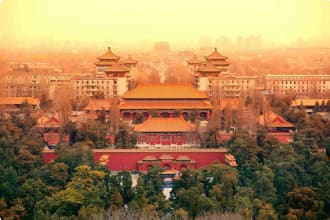
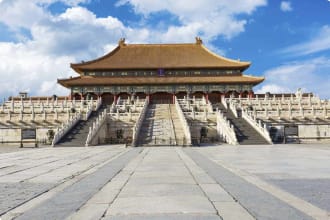
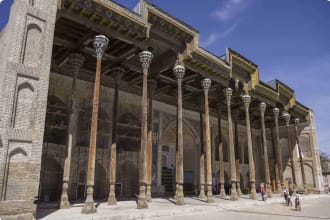

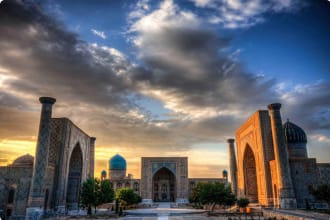
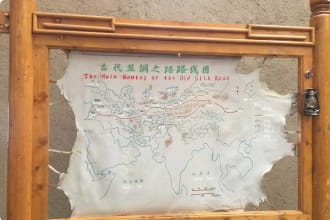
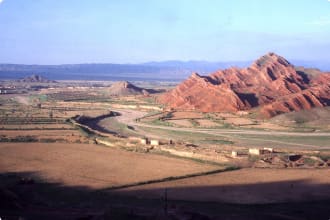
Itinerary
29 days
Day 1: Xian
Accommodation: Grand Dynasty Culture Hotel or similar
Upon arrival in Xian, we make our own way to our hotel. Remnants of the ancient Chinese capital of Chang’an (“Perpetual Peace”) can still be seen behind the sheen of modern Xian, as many of its monuments, Ming-era city walls, and Muslim Quarter still stand. Chang’an was the capital of more than ten Chinese dynasties, reaching its apex under the Tang Dynasty as it grew to become the home of more than a million Chinese and foreigners, comparable to the population of a modern metropolis. Nara, Japan’s first permanent capital, as well as the thousand-year capital Kyoto were modelled on Chang’an’s grid-like layout. We will start our tour with an introductory meeting in the late afternoon, followed by a welcome dinner. (D)
Day 2: Xian
Accommodation: Grand Dynasty Culture Hotel or similar
Xian is most famous for its Army of the Terracotta Warriors, and today we will visit this life-size army guarding the tomb of Emperor Qin Shi Huang, the first emperor of a unified China. It is one of the most famous archaeological finds in the world, the underground vault containing the warriors, bronze chariots, and horses discovered fortuitously in 1974 by workers drilling a well. We will also visit the Neolithic archaeological site of Banpo Village, which was discovered by workers as well in 1953 in the process of digging a foundation for a factory. Located in the Yellow River Valley, east of Xian, the site covers almost 20 acres and contains stone tools and various artefacts of the Yangshao Culture, which flourished in the Yellow River Valley between 5000 and 3000 BC. The Yangshao Culture was believed to be matrilineal, which meant one’s ancestry was traced through the mother’s line, not the father’s. It was the first large-scale archaeological operation of the People’s Republic of China and is a worthy visit. In the evening, we will enjoy a dumpling banquet whilst entertained by the Tang Dynasty Show, which combines poetry with singing, dancing, and colourful costumes. (B,D)
Day 3: Xian
Accommodation: Grand Dynasty Culture Hotel or similar.
We have a full-day tour of the city. Our first stop is the Big Wild Goose Pagoda, a Buddhist pagoda built during the Tang Dynasty and repaired during the Ming Dynasty. It is a uniquely Tang-style pagoda, with square instead of round floors. A World Heritage Site, the Big Wild Goose Pagoda held figurines of the Buddha and Buddhist texts brought to China from India by the monk Xuanzang. We will also walk the original City Wall, built as a military defence system, and which still surrounds the entire city to this day. After this we will be taken on a walk that will end at the Forest of Stone Steles Museum. Chinese steles are rectangular stone tablets upon which Chinese characters forming a funerary, commemorative, or edifying text are inscribed. They can also contain poems, portraits, or maps, and will be of great interest for fans of the art of Chinese calligraphy. We will visit the Muslim Quarter and see the Great Mosque, one of the oldest, largest, and best-preserved Islamic mosques. The Muslim enclave inside the city can be traced back to the Tang Dynasty, when Muslim merchants came and stayed in Chang’an via the Silk Road. We will also visit the Drum Tower, which towers over the city and signals the end of the day with the beating of a huge drum at sunset. Today’s sightseeing is concluded with a visit to the Provincial Museum which is one of best museums displaying China’s ancient civilisation. (B,L,D)
Day 4: Xian - Lanzhou
Accommodation: Grand Soluxe Hotel Gansu or similar
This morning we take a high-speed train to Lanzhou,the capital of Gansu province in west-central China. In the afternoon we visit the seven-story White Pagoda, nestled in the mountains on the northern bank of the Yellow River. The top of the White Pagoda offers a bird’s-eye view of Lanzhou. We will then take a stroll along the Yellow River and view the Lanzhou Ancient Water Mill, a unique, circular structure made of wood serving as an irrigation implement dating back to the Ming dynasty. (B,D)
Day 5: Lanzhou - Xiahe
Accommodation: Jiusheng International Hotel or similar
From Lanzhou, we will travel by coach to Xiahe where we visit the Labarang Monastery. Xiahe is an ethnically Tibetan town in the People’s Republic of China, and is famous for the Labrang Monastery, a monastery of the Yellow Hat sect (Gelug) of Tibetan Buddhism. An important member of the Yellow Hat sect is the Dalai Lama, the spiritual leader of the Tibetan people. Located on the Daxia River and founded in 1709, this monastery is home to the largest population of monks outside of the Tibet Autonomous Region. With its chapels, temple halls, living quarters for the monks, and monastic colleges, Labrang can be considered a monastic town unto itself. (B,D)
Day 6: Xiahe - Lanzhou
Accommodation: Grand Soluxe Hotel Gansu or similar
After breakfast we travel back to Lanzhou and in the afternoon we visit the Gansu Provincial Museum, which contains 350,000 pieces of cultural relics, including the famous Flying Horse of Gansu, a bronze sculpture from the Eastern Han dynasty dating back to circa 2nd century AD. Before the Silk Road was formally opened, Han emissary Zhang Qian’s report about a new breed of horses he found in Central Asia, larger and more powerful than the small local breed of horses that the Chinese use, became a sensation at the imperial court. The Han Dynasty acquired these warhorses (depicted in this bronze sculpture) to fight their nomadic invaders. (B,L,D)
Day 7: Lanzhou - Jiayguan
Accommodation: Plaza Holiday Inn or similar
From Lanzhou we take a high-speed train to Jiayuguan, which sits in the Gobi Desert. It is most famous for the Jiayu Pass of the Great Wall of China. “Jiayu Pass” is the English translation of the city’s name (“Jiayuguan”), as this frontier town grew from the pass built at the western end of the Great Wall during the reign of the Ming Dynasty. A vital passage way on the Silk Road, Jiayu Pass became surrounded with inns for merchants, who eventually stayed and made the area their home. Remarkably, the entire fortress is intact and its mighty walls soar up as if defying nature and the stark desert surroundings. But as huge as the fort is, it is dwarfed by the snow-capped peaks of the Tian Shan mountain range, which reaches a height of 5,547 metres. We will also visit the Overhanging Great Wall, a steep section of the pass, and the Great Wall Museum. (B,L,D)
Day 8: Jiayuguan - Dunhuang
Accommodation: The Silk Road Dunhuang Hotel or similar
Today we travel by coach to the Dunhuang region, an oasis town and a major stop on the Silk Road. From the west, Dunhuang was the first trading town reached by Silk Road merchants entering Chinese-administered territory. It is in this region that the Great Wall finally peters out and vanishes into the dust of the Gansu Desert. (B,L,D)
Day 9: Dunhunag
Accommodation: The Silk Road Dunhuang Hotel or similar
Today we cross the Gansu desert to the Mogao Grottoes, inscribed on UNESCO’s World Heritage List and which form part of the ruins of the Yumen and Yangguan Passes, the westernmost gates of the Gate Wall. The Mogao Grottoes are also called the Mogao Caves or the “Caves of the Thousand Buddhas”. Dunhuang was a centre of Buddhism from the 4th century. In 366, Buddhist monks and missionaries founded the first of the caves, turning the town into a major place of Buddhist pilgrimage. The 492 decorated caves contain 2,000 statues and 45,000 murals, representing the finest example of Buddhist cave art. Afterwards, we will have a tour to Crescent Spring, a lake in the shape of a perfect half-moon, and Singing Sands Mountain, a giant dune said to make the sound of chimes as the wind blows over the sand. (B,L,D)
Day 10: Dunhuang - Turpan
Accommodation: Shuangcheng Hotel or similar
Today, we transfer by coach to Liuyang station and take a high-speed train north-west to Turpan. (B,D)
Day 11: Turpan
Accommodation: Shuangcheng Hotel or similar
Turpan, lying at 154 metres below sea level, is the second-lowest depression in the world and the lowest elevation in China. Known as Gaochang in antiquity, Turpan served as a frontier town on the Silk Road, serving as a stopover for travellers. One can just imagine how fascinating Turpan must have been to the ancient merchants. We will visit the Flaming Mountains, hills of red sandstone that spread out for fifty kilometres. In the classic Chinese novel Journey to the West, the Monkey King knocked over a kiln in the heavens and the embers fell from the sky to where the Flaming Mountains are now. The red sandstone looks fiery but the mountain climate can also be very hot—reaching 50 °C (122 °F) or higher. The Bezeklik Thousand Buddha Caves lies under the cliffs of the Flaming Mountains. Like the Dunhuang grottoes, the Bezeklik Caves also contain Buddhist art. We will also visit the ruins of Gaochang, the ancient city from which Turpan sprung, and the Ancient Astana Tombs. After lunch we will visit Aydingkol Lake, which thousands of years ago was a freshwater lake, but has now dried to a salt rime. (B,L)
Day 12: Turpan - Urumqi
Accommodation: Jin Jiang International Hotel Urumqi or similar
This morning we will visit Grape Valley, where grapes are cultivated on arid land. The Sugong Minaret (or Sugong Ta), a brick tower dating back to the 1770s, is also a worthy stop. Made of mud brick, it survived in the desert for more than 200 years due to very little rainfall in the area. We will also view the Karez ancient irrigation system, which is made up of a series of vertically dug wells linked by underground water canals collecting water from the base of the Tian Shan Mountains and the Flaming Mountains, an ingenious system that supported ancient populations. After lunch we transfer to Urumqi by coach, en route passing a large wind-powered power plant. Urumqi is the capital city of the Xinjiang Uighur Autonomous Region, set within the Tian Shan Mountains. (B,L)
Day 13: Urumqi
Accommodation: Jin Jiang International Hotel Urumqi or similar
Today we have an early-morning start for our full-day tour to Heavenly Lake, where we will enjoy a tranquil boat ride. Our coach travels 50 kilometres through the grazing lands of the Uighurs and Kazakhs. Their sheep, cattle, and horses never stray far from the yurts of these nomadic folk. We will see the impressive “Peak of God” (Bogda Feng), which soars 5,445 metres from the desert floor. Halfway up the mountain is the most beautiful of alpine lakes, the aptly named “Lake of Heaven,” fed by Mt. Bogda glacier and surrounded by pine and fir trees. (B,L,D)
Day 14: Urumqi - Kashgar
Accommodation: Tianyuan International Hotel or similar
We transfer this morning to the airport for our flight to Kashgar, one of the westernmost cities of China, closer to Afghanistan, Kyrgyzstan, Pakistan, and Tajikistan than Beijing. It is a trading stop on the Silk Road, and was once under the rule of Chinese, Turkic, Mongol, and Tibetan empires, their influences evident on the city’s architecture. On arrival in Kashgar we will be taken on a sightseeing tour, which includes the beautiful Abakhoja Romb, the Grand Idagh Mosque and Arts and Crafts street. We also visit the Old Russian embassy and the British embassy. Kashgar is a fabled city which, until recent years, was closed to Westerners. This oasis town is steeped in mystery and intrigue, and reminds one more of Casablanca or Marrakesh than a Chinese town. The standard form of taxi is a donkey cart and as you lose yourself in the dusty, backstreet markets of the Old Quarter you will stumble across many a rare treasure for which you will have to bargain fiercely. (B,L,D)
Day 15: Kashgar - Torugart Pass - Naryn
Accommodation: Khan-Tengri Guest House or similar
Today we have to prepare ourselves for a long ride as we will drive through the Torugart Pass and into Kyrgyzstan. The Torugart Pass, sitting 3,752 metres above sea level, is a mountain pass in the Tian Shan mountain range between China and Kyrgyztan. We first ride to the Torugart Pass by coach and undertake Chinese border formalities while enjoying the view of the picturesque mountain range. We then travel another seven (7) kilometres to the Kyrgyzstan border point, before continuing along the dusty road to Naryn. Please note that due to the conditions of this road we shall be using smaller vehicles for this section. During this trip we will pass many fields full of wild horses and have fantastic views of the Tian Shan Mountains. En route to Naryn we will pause to view an old caravanserai, Tash Rabat. Caravanserai are roadside inns that dotted the Silk Road to provide a place for travellers to rest and recover. The name was derived from the Persian compound word karvansaray (combining karvan “caravan” with saray “palace”). These inns were built with a central open-air courtyard. Tash Rabat (“tash” means “stone” in the Kyrgz language) is described as a 16th-century caravanserai, but many believe it may date back to the 9th or 10th centuries when Arabs penetrated China via this route. Located in the mountains, Tash Rabat offered perfect protection to Silk Road merchants and travellers against brutal weather conditions such as heavy snow and freezing temperatures. Due to the nature of the terrain, there are no restrooms available en route to Naryn. However, when needed, our vehicles will pull over for toilet stops. A pre-packed lunch will be provided for us. On arrival in Naryn we will transfer to our hotel, and spend the remainder of the day at our leisure. Naryn is a small town yet untouched by mass tourism, and will offer solace as we rest after the long journey. (B,L,D)
Day 16: Naryn - Issyk-Kul
Accommodation: Royal Beach Resort or similar
This morning we drive via the picturesque Dolan Pass to Issyk Kul, a lake in the northern Tian Shan mountains and a significant resting point on the northern branch of the Silk Road. In the Kyrgz language, its name means “warm lake” because it never freezes. It is the second largest saline lake after the Caspian Sea. This afternoon we visit the Cholpan Ata Bazaar and view rock drawings dating from the 1st century BC to the 7th century AD. We will have an excursion to the Petroglyphs’ Museum which contains a number of prehistoric monumental structures and petroglyphs dating from the 2nd millennium BC up to the Middle Ages up to the 6th century. (B,L,D)
Day 17: Issyk-Kul - Karakol - Issyk-Kul
Accommodation: Royal Beach Resort or similar
This morning we drive to the capital of Issyk-Kul Lake region – Karakol for sightseeing tour, we stop to visit Prjevalsky Museum followed by lunch at a local café. We then visit the Russian Orthodox Church and the Dungan Mosque, built in a Buddhist pagoda style in wood without a single nail. Later we return to our hotel. (B,L,D)
Day 18: Issyk-Kul - Bishkek
Accommodation: Park Hotel or similar
Today we have an early morning departure for Bishkek, the capital of the Republic of Kyrgyzstan, located 400 kilometres to the west of Issyk Kul. En route, we pause at Burana, the ruins of a 9th to 11th century caravan town from the period of the Turkic Karakhanid Dynasty. We will view the surviving Burana tower and the nearby archaeological museum. We arrive at Bishkek in time for a late lunch. After lunch, we have a short orientation regarding Bishkek, a modern city with vast squares, crowded bazaars, impressive administrative centres, and educational institutions. Bishkek was captured by the Russians in 1862. It became the administrative centre of the Kyrgyz autonomous province (later re-named the Kyrgyz Autonomous Soviet Socialist Republic) in 1924, and like other former Soviet Union republics declared its independence in 1991 upon the dissolution of the USSR. As the major industrial centre of the republic, Bishkek’s factories produce leather goods, agricultural machinery, and a variety of textiles. We will visit the History Museum and the Tsum (Soviet-period supermarket). Dinner will be at a local restaurant, accompanied by traditional music. (B,L,D)
Day 19: Bishkek - Ala Archa - Bishkek - Tashkent
Accommodation: City Palace Hotel or similar
After breakfast, we transfer to Ala-Archa Canyon, famous for its perpetual snow stretching for 200 kilometres. This unique alpine national park is one of the main attractions in Kyrgyztan and is located not far from Bishkek. The park, which includes the gorge of the Ala-Archa River and the mountains surrounding it, is famous for its beauty. It is also home to a number of rare plants and birds. “Ala-Archa” means “many-coloured juniper” after the trees found in abundance in the area. After a walk in Ala-Archa National Park, we return to Bishkek for lunch at a local cafe, before making our way to the airport for our evening flight to Tashkent, the capital of Uzbekistan. On arrival, we are transferred to our hotel. (B,L,D)
Day 20: Tashkent - Nukus - Khiva
Accommodation: Asia Khiva Hotel or similar
We have a very early start today as we head back to the airport for a flight to Nukus. On arrival we’ll be met and take a sightseeing tour of the city with a visit to the Savitsky Art Museum, which houses the second most valuable collection of paintings by the Russian avant-garde artist Igor Savistky. We’l also visit an Embroidery centre of Gulnara Egamberdieva and a local yurt making family. After lunch at a local restaurant we travel about 4hrs to Khiva where we spend the next 2 nights. Khiva is on the Amu-Darya, the longest of the 2 rivers that run east to west across Central Asia, and so has a long history of agriculture in an otherwise arid environment. It was also a trading post and on a minor branch of the Silk Road trading route. Following Tamerlane’s (Timur) plundering and destructive campaigns of the late 1300s, Khiva became capital of Korozem khanate. Its inner city is packed with many religious buildings and buildings from past rulers. (B,L,D)
Day 21: Khiva
Accommodation: Asia Khiva Hotel or similar
We spend the day exploring this amazing city. We visit Kalta Minor Minaret, the Kunya ark fortress with administrative buildings, gunpowder works, law courts, mosque, the Pakhlavan Makhmud complex, the most remarkable architecture memorial complex in Khiva with unique tiles, and Ak-Sheikh Baba Observation platform. After lunch at a local restaurant we continue our sightseeing and visit Islam Khodja minaret, built in 1908 it is the highest building In Khiva. Djuma Mosque, cathedral mosque with a roof which lies on 212 wooden fretted columns and lastly we visit Tash Hovli Palace, the summer residence of Khiva Khans, built in the 19th century. (B,L,D)
Day 22: Khiva - Bukhara
Accommodation: Asia Bukhara Hotel or similar
This morning, we travel by coach to Bukhara, an ancient city and prominent stop on the Silk Road. In addition to being a trade stop, Bukhara also served as a major centre of Islamic theology, scholarship, and culture. UNESCO has listed the city’s historic centre, home to numerous mosques and madrasas (educational institutions), as a World Heritage Site. En route we stop to appreciate the fauna and flore of the Kyzyl Kum desert, for centuries it marked the northern limit of Transoxiana and the edge of the boundless nomadic steppe. Lunch will be at Chaihana, in the desert. We’ll arrive late afternoon in Bukhara. (B,L,D)
Day 23: Bukhara
Accommodation: Asia Bukhara Hotel or similar
We start our sightseeing with the Ark of Bukhara, a fortress built in the 5th century, followed by the Ismoil Somoni Mausoleum. We pause for lunch at a local restaurant and continue our sightseeing afterwards. We will visit the Poikalon complex, which consists of three structures: Minorai Kalin, Masjidi Kalon and Miri Arab Madrassah. Next, we explore the Labi Havz, which translates as “ensemble near the pool”. There are three monumental structures here, too: the Kukeldash Madrassah, Nadir Devanbegi Madrassah and Nadir Devanbagi Khanaka, all of which date from the 16th century. Finally, we pay a visit to the Maggoki Attari Mosque, before retiring for dinner and an Uzbek dance show. (B,L,D)
Day 24: Bukhara - Giduvan - Samarkand
Accommodation: Registan Plaza Hotel or similar
Today we travel by coach to Samarkand, which like Bukhara was a great Silk Road city and a centre for Islamic scholarship. The city centre is on the World Heritage List. En route we will visit Sitora-i-Mokhikhosa, the Summer Palace of the Former Emir of Bukhara. En route we stop to at the small town of Gijduvan to see the traditional pottery works of Alisher. Lunch will be with Alisher’s family. We arrive at our hotel in Samarkand in the early evening for dinner. (B,L,D)
Day 25: Samarkand
Accommodation: Registan Plaza Hotel or similar
We have a morning tour including a visit to Ulugbek’s Observatory, Afrosiab Museum and archaeological sites and Shahi Zinda Necropolis, a series of intricately designed tombs continually constructed over many centuries. After lunch at a local restaurant we continue our sightseeing with Registan Square to see the three beautiful madrasas, Shirdor, Ulugbek, and Tilla Kari followed by a visit to Gur Emir Mausoleum. Dinner will be at a local Uzbek family home. (B,L,D)
Day 26: Samarkand - Shakre Sabz - Samarkand
Accommodation: Registan Plaza Hotel or similar
Today we will go on an excursion to Shakre Sabz, the birthplace of the Turkic conqueror Tamerlane (Timur). Of Mongol ancestry and known in history as a brutal warrior, Tamerlane established a vast empire in the 14th century, which included Turkistan, Afghanistan, Persia, Syria, southern Russia, and India. Under his reign, Samarkand became a beautiful city as Tamerlane was an eager patron of art and scholarship. His empire did not survive after his death in 1405. We will see the ruins of Tamerlane’s summer residence, the Ak Saray Palace; Dorus Tilavat Seminary, Kok Gumbaz Mosque and Dorus Saidat. Lunch will be at a local restaurant and later in the afternoon we return to Samarkand (approx. 3hrs drive). Dinner will be at the hotel. (B,L,D)
Day 27: Samarkand – Tashkent
Accommodation: City Palace Hotel or similar
We have a free morning in Samarkand for personal sightseeing or resting. We check-out of the hotel at noon and have lunch at a local restaurant. We’ll enjoy a little more sightseeing including visit to the Bibi Khanum Mosque and Siab Bazaar. In the late afternoon we are transferred to the trains station and catch the high-speed train to Tashkent. On arrival in Tashkent we will be transferred to our hotel. We will have dinner in a local restaurant. (B,L,D)
Day 28: Tashkent
Accommodation: City Palace Hotel or similar
After having our fill of Samarkand, we will now turn our attention to the capital of Uzbekistan, Tashkent. This city boasts of more than 2,000 years of written history. In 1219, Tashkent was destroyed by Genghis Khan, but was rebuilt and became prosperous from profits brought by the Silk Road. Its name is derived from the Persian word for “city” (chach). After the 16th century, the name evolved from Chashkand to Tashkand. The modern spelling “Tashkent” reflects 20th-century Soviet influence. Developments in the city after the 1991 dissolution of the Soviet Union sought to replace icons from the Soviet era, such as the statue of Lenin now replaced with a structure of a globe, called the Monument of Independence of Uzbekistan. This morning we will visit Hast Imam complex, Barak Khana, and the Tila Shaikh Mosque and archives. Later we proceed to Chorsu Bazaar, Kukeldesh Madrassah and the History Museum and a ride on the Tashkent Metro, its stations are among the most ornate in the world. Lunch will be at a local restaurant. In the afternoon we will be taken to the Navoi Theatre and shall see the day’s performance, pending their schedule. Tonight we will be treated to a farewell dinner at a local restaurant. (B,L,D)
Day 29: Tashkent
Our tour concludes after breakfast, however we may offer optional activities if the group flight is scheduled for an evening departure, such as a visit to the Fine Arts Museum, Amir Timur Museum and Park during the afternoon. Note: A transfer to the airport is included if all participants are departing at the same time (flight details will be advised approximately 60 days prior to start date of the tour) (B)
Tour Notes
- Where overnight trains are used, no single compartments are available. Shared compartments only.
Includes / Excludes
What’s included in our Tour
- 28 nights of hotel accommodation.
- 28 breakfasts, 23 lunches, and 26 dinners.
- Internal flight sectors are included as per itinerary, economy class.
- Touring in best available air-conditioned coaches.
- All transfers and porterage (1 bag per person) while on tour (day 2 to Day 18) except in local airports where porterage is usually not available.
- Comprehensive sightseeing tours with English speaking guides, including all entrances fees throughout.
- Tipping and gratuities.
- Services of a Tour Leader.
What’s not included in our Tour
- International airfares and departure taxes.
- Comprehensive international travel insurance.
- Visa fees, where required.
- Meals on the trains.
- Arrival and departure transfers (start/end) of tour.
- Items of a personal nature eg. Drinks, telephone calls, laundry.
Participants must be able to carry their own luggage, climb and descend stairs, be in good health, mobile and able to participate in 3-5 hours of physical activity per day, the equivalent of walking / hiking up to 8 kilometers per day on uneven ground.
Book now
Make it a private tour
Easing your journey
Crossing international borders with restrictions
The list of requirements to travel internationally has changed and will continue to change for several years. Odyssey is here to assist you in managing your way through these requirements:
For more information see our Crossing international borders with restrictions page.
Book With Confidence
If less than 30 days before your tour starts you are unable to travel as a result of Government travel restrictions, Odyssey Traveller will assist you with a date change, provide you with a credit or process a refund for your booking less any non-recoverable costs.
See Terms and conditions for details.
Peace of Mind Travel
The safety of our travellers, tour leader, local guide and support staff has always been our top priority and with the new guidelines for public health and safety for keeping safe for destinations around the world, we’ve developed our plan to give you peace of mind when travelling with us.
See Peace of Mind Travel for details.
Reading List Download PDF
Foreign Devils on the Silk Road
Hopkirk, Peter
The Silk Road, which linked imperial Rome and distant China, was once the greatest thoroughfare on earth. Along it traveled precious cargoes of silk, gold and ivory, as well as revolutionary new ideas. Its oasis towns blossomed into thriving centers of Buddhist art and learning. In time it began to decline. The traffic slowed, the merchants left and finally its towns vanished beneath the desert sands to be forgotten for a thousand years; however, legends grew up of lost cities filled with treasures and guarded by demons. In the early years of the last century foreign explorers began to investigate these legends, and very soon an international race began for the art treasures of the Silk Road. Huge wall paintings, sculptures and priceless manuscripts were carried away, literally by the ton, and are today scattered through the museums of a dozen countries. Peter Hopkirk tells the story of the intrepid men who, at great personal risk, led these long-range archaeological raids, incurring the undying wrath of the Chinese.
The Silk Roads: A New History of the World
Peter Frankopan
The sun is setting on the Western world. Slowly but surely, the direction in which the world spins has reversed: where for the last five centuries the globe turned westwards on its axis, it now turns to the east.
For centuries, fame and fortune was to be found in the west in the New World of the Americas. Today, it is the east which calls out to those in search of adventure and riches. The region stretching from eastern Europe and sweeping right across Central Asia deep into China and India, is taking centre stage in international politics, commerce and culture and is shaping the modern world.
This region, the true centre of the earth, is obscure to many in the English-speaking world. Yet this is where civilization itself began, where the world's great religions were born and took root. The Silk Roads were no exotic series of connections, but networks that linked continents and oceans together. Along them flowed ideas, goods, disease and death. This was where empires were won and where they were lost. As a new era emerges, the patterns of exchange are mirroring those that have criss-crossed Asia for millennia. The Silk Roads are rising again.
A major reassessment of world history, The Silk Roads is an important account of the forces that have shaped the global economy and the political renaissance in the re-emerging east.
The Silk Road: A Very Short Introduction
James A. Millward
The phrase "silk road" evokes vivid images: of merchants leading camel caravans over deserts and steppes to trade exotic goods in the bazaars of glittering Oriental cities, of pilgrims braving bandits and frozen mountain passes to gather scriptures and spread their faith across continental expanses. Beyond the exotica, however, this VSI will be a sketch of the historical background against which the silk road flourished, and an essay on the significance of old-world intercultural exchange to Eurasian and world history generally. On the one hand, Millward treats the silk road broadly, as a metonym for the cross-fertilizing communication between peoples across the Eurasian continent since at least the Neolithic era. On the other, he highlights specific examples of goods and ideas exchanged between the Mediterranean, Persian, Indian, and Chinese regions, along with the significance of these exchanges. While including silks, spices, travelers' tales of colorful locales, the main focus of the book is to outline the dynamics of Central Eurasian history that promoted silk road interactions, especially the role of nomad empires; and to highlight the importance of the biological, technological, artistic, intellectual, and religious interchanges across the continent. Millward shows that these exchanges had a profound effect on the old world that was akin to, if not yet on the scale of, modern globalization.
Millward also considers some of the more abstract contemporary uses to which the silk road concept has been put. It is, of course, a popular marketing device for boutiques, museums, restaurants, and tour operators from Venice to Kyoto. More than that, however, the silk road has ideological connotations, used sometimes to soften the face of Chinese expansion in Central Asia, or, in the US culture wars, as a challenge to the "clash of civilizations" understanding of intersocietal relations. Finally, while it has often been argued that the silk road declined or closed after the collapse of the Mongol empire or the opening of direct maritime communications from Europe to Asia, Millard disputes this view, showing how silk road phenomena continued through the early modern and modern expansion of Russian and Chinese states across Central Asia.
Foreign Devils on the Silk Road: The Search for the Lost Treasures of Central Asia
Peter Hopkirk
The Silk Road, which linked imperial Rome and distant China, was once the greatest thoroughfare on earth. Along it travelled precious cargoes of silk, gold and ivory, as well as revolutionary new ideas. Its oasis towns blossomed into thriving centres of Buddhist art and learning.
In time it began to decline. The traffic slowed, the merchants left and finally its towns vanished beneath the desert sands to be forgotten for a thousand years. But legends grew up of lost cities filled with treasures and guarded by demons. In the early years of the last century foreign explorers began to investigate these legends, and very soon an international race began for the art treasures of the Silk Road. Huge wall paintings, sculptures and priceless manuscripts were carried away, literally by the ton, and are today scattered through the museums of a dozen countries.
Peter Hopkirk tells the story of the intrepid men who, at great personal risk, led these long-range archaeological raids, incurring the undying wrath of the Chinese.
The Silk Road - Central Asia, Afghanistan and Iran: A Travel Companion
Jonathan Tucker
Stretching from the ancient Chinese capital of Xian across the expanses of Central Asia to Rome, the Silk Road was, for 2,000 years, a vibrant network of arteries that carried the lifeblood of nations across the world. Along a multitude of routes everything was exchanged: exotic goods, art, knowledge, religion, philosophy, disease and war. From the East came silk, tea, jade, paper, porcelain, spices and Buddhism; from the West, horses, weapons, lions, precious stones and cotton. From its earliest beginnings in the days of Alexander the Great and the Han Dynasty, the Silk Road expanded and evolved, reaching its peak under the Tang and Byzantine empires and gradually crumbling along with the decline of the Mongol empire. In this beautifully-illustrated book, which covers the Central Asian section of the Silk Road - from Lake Issy Kul through Tashkent, Samarkand, Bukhara, the Kyzyl Kum Desert, Khiva and Merv to Herat, Kabul and Iran - Jonathan Tucker uses traveller’s anecdotes and a wealth of literary and historical sources to celebrate the cultural heritage of the countries that lie along the Silk Road and illuminate the lives of those who once travelled through the very heart of the world.
China's Asian Dream: Empire Building along the New Silk Road
Tom Miller
"China", Napoleon once remarked, "is a sleeping lion. Let her sleep, for when she wakes she will shake the world." In 2014, President Xi Jinping triumphantly declared the lion had awakened. Under his leadership, China is pursuing a dream to restore its historical position as the dominant power in Asia.
From the Mekong River Basin to the Central Asian steppe, China is flexing its economic muscles for strategic ends. By setting up new regional financial institutions, Beijing is challenging the post-World War II order established under the watchful eye of Washington. And by funding and building roads, railways, ports and power lines—a New Silk Road across Eurasia and through the South China Sea and Indian Ocean—China aims to draw its neighbours ever tighter into its embrace.
Combining a geopolitical overview with on-the-ground reportage from a dozen countries, China’s Asian Dream offers a fresh perspective on the rise of China’ and what it means for the future of Asia?
The Silk Road in World History
Xinru Liu
The Silk Road was the contemporary name for a complex of ancient trade routes linking East Asia with Central Asia, South Asia, and the Mediterranean world. This network of exchange emerged along the borders between agricultural China and the steppe nomads during the Han Dynasty (206 B.C.E.-220 C.E.), in consequence of the inter-dependence and the conflicts of these two distinctive societies. In their quest for horses, fragrances, spices, gems, glassware, and other exotics from the lands to their west, the Han Empire extended its dominion over the oases around the Takla Makan Desert and sent silk all the way to the Mediterranean, either through the land routes leading to the caravan city of Palmyra in Syria desert, or by way of northwest India, the Arabian Sea and the Red Sea, landing at Alexandria. The Silk Road survived the turmoil of the demise of the Han and Roman Empires, reached its golden age during the early middle age, when the Byzantine Empire and the Tang Empire became centres of silk culture and established the models for high culture of the Eurasian world. The coming of Islam extended silk culture to an even larger area and paved the way for an expanded market for textiles and other commodities. By the 11th century, however, the Silk Road was in decline because of intense competition from the sea routes of the Indian Ocean. Using supply and demand as the framework for analysing the formation and development of the Silk Road, the book examines the dynamics of the interactions of the nomadic pastoralists with sedentary agriculturalists, and the spread of new ideas, religions, and values into the world of commerce, thus illustrating the cultural forces underlying material transactions. This effort at tracing the interconnections of the diverse participants in the transcontinental Silk Road exchange will demonstrate that the world had been linked through economic and ideological forces long before the modern era.
Travel on the Silk Road with Odyssey Traveller | Small Group Tour for Seniors

